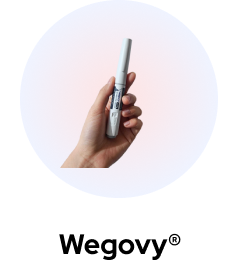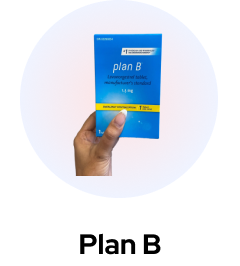In this article we’ll cover:
- What Ozempic is
- How Ozempic is used in the treatment of type 2 diabetes
- How Ozempic may be helpful for weight management
- Any safety considerations you should bear in mind
- Frequently asked questions.
Ready to learn more? Read on!
What Is Ozempic?
Ozempic is the brand name for semaglutide. You may also see it marketed under the brand names Wegovy or Rybelsus.
Semaglutide is part of a larger class of drugs called glucagon-like peptide-1 (GLP-1) receptor agonists. This imitates how GLP-1 hormones work, which keep your insulin and blood sugar levels under control, while also slowing your digestion.
Ozempic comes as an Ozempic Pen — similar to an EpiPen. It’s administered as a subcutaneous injection (ie, into the fatty layer beneath the skin) by patients once a week.
Doses may vary depending on your personal health plan. Your medical team will be able to advise you on this and provide you with full information.
Uses of Ozempic
Ozempic was created for the treatment of type 2 diabetes. Additionally, it may also help to reduce risk of major cardiovascular events. This includes heart attack, stroke, hypertension, or death.
However, a positive side effect has been Ozempic’s potential as a weight management tool, especially when combined with lifestyle changes, including eating healthy foods and regular exercise.
Health Canada has approved Ozempic for the treatment of type 2 diabetes in adults, or for assistance with weight management in individuals who have a body mass index (BMI) or 27 or higher.
Ozempic is not approved for the treatment of children or those with type 1 diabetes. It is only available by prescription, and you should consult with your medical team about your full medical history before beginning the drug.
Ozempic for the Treatment of Type 2 Diabetes
Ozempic is primarily used in the treatment of people with type 2 diabetes, and multiple studies and anecdotal evidence have attested to its efficacy.
How Does It Work?
The active ingredient in Ozempic, semaglutide, increases the secretion of insulin from the pancreas when your body’s blood sugar levels are high. It does this by mimicking the human incretin glucagon-like peptide-1 (GLP-1), which promotes insulin secretion and blood sugar disposal.
As insulin prevents blood sugar spikes, that means that semaglutide can help type 2 diabetics with their glycemic control, and prevent hyperglycemia.
Additionally, semaglutide assists with suppression of glucagon production. Since glucose is produced by the liver when stimulated by glucagon, this means that it won’t be able to produce more glucose, thereby raising your blood sugar levels.
Benefits
For type 2 diabetics, Ozempic lowers your A1C and helps you with your glycemic control.
Side Effects
There are a number of side effects you should be aware of when starting semaglutide — this is not uncommon with a new medicine.
While the most commonly reported dissipate over time, there are also some more serious (but rare) side effects that you should pay attention to.
Commonly reported side effects include:
- Nausea and headache
- Vomiting
- Diarrhea
- Abdominal (stomach) pain
- Constipation.
More serious but rare side effects include:
- Risk of medullary thyroid carcinoma (MTC; thyroid cancer)
- Pancreatitis (inflammation of the pancreas)
- Changes in vision or issues with eyes (diabetic retinopathy)
- Hypoglycemia
- Kidney problems
- Gallbladder issues
- Allergic reactions.
Allergic reactions may manifest as swelling of the face, lips, tongue, or throat, difficulty breathing after administration of Ozempic, or an itchy rash or hives around the injection site.
Additionally, clinical studies on mice administered with semaglutide showed that they developed thyroid tumors. While it’s unknown if the same result would appear in humans, if you develop soreness or lumps in your neck, you should discontinue your use of Ozempic.
If you develop any symptoms or signs of the more serious side effects while using Ozempic, discontinue your use immediately and contact your medical team, or visit the ER at your local hospital.
Dosage and Interactions
Ozempic currently comes in three Ozempic Pens which may administer the different approved dosages. These are:
- The red label – Able to administer 0.25 mg and 0.5 mg doses. Contains 2 mg.
- The blue label – Able to administer 1 mg doses. Contains 4 mg.
- The yellow label – Able to administer 2 mg doses. Contains 8 mg.
A prescription includes four pens with needles (enough for a month).
Dosages are self-administered once weekly by the patient using the Ozempic Pen subcutaneously, ie, beneath the skin into the fatty layer of tissue. Patients should take care not to inject into muscle or blood veins, and should rotate the injection site each time.
If you are unsure how to self-administer your dosage, your medical team, Nurse Practitioner, or pharmacist may be able to give you further instruction. Novo Nordisk also has a handy page on their website with video instruction.
While the dosage will be different for everyone, depending on your personal circumstances, generally speaking most start on a dose of 0.25 mg. At week 4, this is increased to 0.5 mg, which is then maintained for the duration of your treatment.
For those who need more management, you may be prescribed either 1 mg or 2 mg of Ozempic (the highest available dosage).
There are a number of contraindications associated with semaglutide. For that reason, you should ensure that you communicate with your medical team about any and all prescription medications you’re currently taking, including supplements and vitamins, before you start Ozempic.
Weight Loss Benefits of Ozempic
An interesting and beneficial side effect is that with the increased insulin production and glucagon suppression comes suppressed appetite. Additionally, GLP-1 can have an effect on the hunger centers of the brain, and slow gastric emptying.
All this means lower hunger levels, increased satiety, feeling fuller for longer, and a reduction in calorie consumption, putting you into a calorie deficit.
Thanks to this, Ozempic can be a highly effective tool in weight management, especially when combined with a healthy diet and exercise.
You should note, however, that Health Canada has only approved Ozempic for use as a weight management tool in those with a BMI of 27 or higher, and you will require a prescription.
If you’re interested in Ozempic for weight management and meet this criteria (with or without type 2 diabetes), talk to your medical team or Nurse Practitioner for more information.
Other Benefits of Ozempic
Use of Ozempic may improve your overall general health. Multiple studies have shown that, in addition to the other benefits already discussed, Ozempic may:
- Reduce your waist measurement and overall body weight
- Improve your health-related quality of life
- Improve your lipid profile.
In addition to lifestyle changes, if you have been prescribed Ozempic for weight management assistance, you may want to consider adjunct therapy. This will help you address any underlying trouble in your relationship with food, and provide you with further support as you embark on your weight management journey.
Be sure to continue communicating with your medical team both during and upon completion of Ozempic treatment.
Heart Disease Prevention
Use of Ozempic can help reduce the risk of major cardiovascular events, such as heart disease, attack, stroke, and death.
Lowering Blood Pressure
Multiple studies, including this one from 2023, have shown that use of Ozempic can lower your systolic and diastolic blood pressure.
However, the study did note that this was in individuals without diabetes and with a normal body mass index (BMI). Further research was required to see if the same effect was found in individuals with obesity.
Safety Considerations With Ozempic Use
Ozempic is considered to be a safe drug, with some provisos.
Do not use Ozempic if you have:
- A personal or family history of pancreatitis
- Type 1 diabetes mellitus
- A personal or family history of MTC
- Are allergic to semaglutide or any of the ingredients in Ozempic.
If you are pregnant, breastfeeding, or planning to conceive, discuss your use of Ozempic with your medical team, as you may need to adjust your treatment plan.
If you are currently using any other prescription medication, supplements, or vitamins, disclose this fully to your medical team so that they may advise you of any contraindications with Ozempic.
Never share your Ozempic Pen with anyone else — even with a fresh needle — as this may increase your risk of infection.
If unopened, store your Ozempic Pen in the refrigerator. Once in use, you may leave it at room temperature.
After use, be sure to dispose of your Ozempic Pen needle in an appropriate sharps container. Your Ozempic pen should be disposed of 56 days after first use.
Key Takeaways
Ozempic, the brand name for semaglutide marketed by Novo Nordisk, is a glucagon-like peptide-1 (GLP-1) receptor agonist. It works by mimicking the natural GLP-1 hormone in your body to control your insulin, blood sugar levels, and slow your digestion.
As such, Ozempic is an excellent drug for the treatment of those with type 2 diabetes, as well as those who may need assistance with weight management.
Health Canada has only approved Ozempic for use in the treatment of type 2 diabetes or for individuals with a BMI of 27 or over. It is a prescription drug and you will need the approval of your health team before you may begin use.
While Ozempic may be an extremely helpful tool for many, be aware that there are several risks and side effects you should familiarize yourself with if you’re considering starting the medication.
Talk to your medical team for full information and guidance, and be sure to disclose to them any prescription medications, supplements, or vitamins you may be taking.
Ozempic Reviews FAQs
How is Ozempic used for weight loss?
Some of the side effects of Ozempic may be helpful in assisting with weight management. This is because Ozempic may affect the hunger centers of the brain and slow gastric emptying. This results in reduced appetite, increased satiety, and suppressed feelings of hunger.
Is it worth taking Ozempic for weight loss?
Many people have successfully been able to manage their weight through use of Ozempic when combined with a healthy diet and exercise. However, Ozempic is currently only approved for use in the treatment of type 2 diabetes, or for those with a BMI over 27.
Talk to your medical team to decide if Ozempic, or another semaglutide medication, will work for your individual goals.
Will Ozempic reduce belly fat?
While it is not possible to target fat loss in any part of the body, the results of positive weight management while using Ozempic may help you lose overall body fat. This may include the reduction of belly fat.
What are the benefits of taking Ozempic?
Ozempic has many potential benefits, which include:
- Reduction of A1C
- Better glycemic control
- Improved lipid profile
- Improved systolic and diastolic blood pressure
- Lowered risk of cardiovascular issues
- Improved weight management.
Results will vary from person to person.











 (US)
(US)